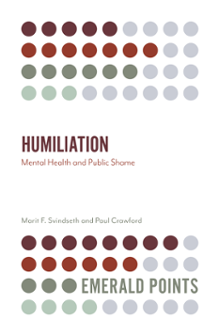
Index
Marit F. Svindseth
(Norwegian University of Science and Technology, Norway)
Paul Crawford
(University of Nottingham, UK)
This content is currently only available as a PDF
Citation
Svindseth, M.F. and Crawford, P. (2019), "Index", Humiliation, Emerald Publishing Limited, Leeds, pp. 121-124. https://doi.org/10.1108/978-1-83867-098-620191006
Publisher
:Emerald Publishing Limited
Copyright © 2019 Marit F. Svindseth and Paul Crawford
INDEX
Ability to hurt others
, 29–30
Abuser
, 25–26
Academic achievement and social pressure
, 45
Acting out
, 36–37
Aggression
, 63–64
Alter ego
, 64–66
Anger
, 39
Anxiety
, 36–37
Arrogance
, 57
Attention
, 53–54
Balanced narcissism
, 54–55
Body shaming
, 20
Bureaucratic humiliation
, 18–19
Compassion
, 78–80
Compensation
, 36–37
Compound humiliation
, 75
Confusion
, 13–15
Continual humiliations
, 41–43
Defence mechanisms
, 35–38, 47–48
self-esteem
, 35–37
Degradation
, 9–13
Depression or anxiety
, 4
Disempowerment
, 63–64
Displacement
, 36–37
Dissociation
, 36–37
Ego
, 35–37
Elderly populations
, 11–12
Embarrassment
, 3–4
Emotional restraint
, 82
Empathy
, 57, 76–77
Emptiness feelings
, 57
Entitlement
, 58
Exclusion
, 20–21
Exhibitionism
, 58
Exploitation of others
, 57
Extremist groups
, 69–70
Extrovert narcissist
, 58–59
Feeling of injustice
, 17–19
Films and photographs
, 4–5
Future humiliations, fear of
, 19–20
Genetics and narcissism
, 52–53
Grandiosity
, 58
Harassment
, 27–29
Healthy narcissism
, 55–56
Helplessness
, 13–15
Human dignity
, 7–8, 78–80
Humiliation
activation for
, 48–50
aspects
, 8–9
on behalf of others
, 71
definitions
, 7–8
elements of
, 8, 48
features of invalidation in
, 48–49
and memory
, 32–33
revisiting cases of
, 82–106
shame and
, 8
to shame transformation
, 25
situational features of
, 48, 49
Idealization and devaluation
, 57
Intellectualization
, 36–37
Interpersonal disputes
, 77–78
Islamic State (IS)
, 64–66, 68
Mental health
, 26
Mental illness
, 63–70
#MeToo campaign
, 27–29
Narcissism
, 26, 50–51
overt vs. covert
, 58–61
symptoms
affective symptoms
, 56–57
grandiosity symptoms
, 58
interpersonal symptoms
, 57
symptoms and traits of
, 51–56
Narcissistic personality disorder
, 66–67
Neutralizing humiliations
, 77–78
toolbox for
, 108–112
Overt vs. covert narcissism
, 58–61
Pathological narcissism
, 56, 58
Personality
, 33–34
Freud’s interacting dimensions of
, 33
trait
, 50–51
Physical assault
, 15–16
Posttraumatic stress disorder (PTSD)
, 32–33
Power
, 30–31
Power balance
, 31, 78–80
Powerlessness
, 13–15
Prestige, success, and brilliance, preoccupation
, 58
Projection
, 36–37
Proxy humiliation
, 31
Psychic decline
, 37–38
Psychological defence mechanisms
, 21
Psychopathology
, 4
Public exposure
, 19–20
and individual values
, 21–23
Public shaming
, 3–4
Rank of status
, 31–32
Rationalization
, 36–37
Reaction formation
, 36–37
Reactions to humiliation
, 42
elements in concept
, 48
mental illness, violence and terrorism
, 63–70
narcissism. See Narcissism
self-esteem and self-image
psychological understanding of
, 47–48
ruining
, 45–47
shame and humiliation
, 41–45
vulnerability and entitlement
, 61–63, 70
Regression
, 36–37
Religious groups
, 69–70
Repression
, 36–37
Roasting
, 31–32
Rumours and accusations
, 44
Sado-masochism
, 4–5
Sanderson’s spectrum of family of shame emotions (adapted)
, 9
Schizophrenic disorder
, 66–67
Self-blame
, 28–29
Self-centred character
, 50–51
Self-defence
, 16–17
Self-esteem
, 13, 16–17, 21, 54–55
defence mechanisms
, 35–37
effect
, 23–24
healthy
, 38–40
labile feelings of
, 56
psychological understanding
, 47–48
ruining
, 45–47
shame and humiliation
, 24–26
Self-evaluation
, 55–56
Self-identity
, 13
Self-image
, 39–40
psychological understanding
, 47–48
ruining
, 45–47
values, and self-esteem
, 34–35
Self-loving
, 50–51
Self- or other-directed violence
, 4
Self-regard
, 55–56
Sense of self and injustice
, 15–16
Shame
, 57
and humiliation
, 8, 24–26, 41–45
Shame-humiliation pairing
, 3–4
‘Slut-shaming’
, 10
‘Social attractedness’
, 5–6
Social media
, 69
Social or economic humiliation
, 107
Social pressure
, 45
Social withdrawal
, 21
So You’ve Been Publicly Shamed?
, 26
Status degradation ceremonies
, 5–6
Status rank
, 78–80
Sublimation
, 36–37
Substance abuse disorders
, 34
Suicide
, 4, 37–38
‘Swot’ blocks
, 20–21
Sympathy
, 76
Terrorism
, 63–70
Unwanted sexual harassment
, 27–28
Violation/assault
, 15–17
Violence
, 16–17, 63–70
and terrorism
, 70
Vulnerability
and entitlement
, 70
to humiliation
, 61–63